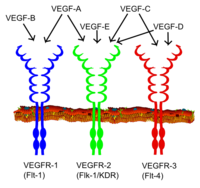
Photo from wikipedia
SUMMARY The canonical mammalian Hippo pathway contains a core kinase signaling cascade requiring upstream MST to form a stable complex with SAV1 in order to phosphorylate the downstream LATS/MOB complex.… Click to show full abstract
SUMMARY The canonical mammalian Hippo pathway contains a core kinase signaling cascade requiring upstream MST to form a stable complex with SAV1 in order to phosphorylate the downstream LATS/MOB complex. Though SAV1 dimerization is essential for the trans-activation of MST, the molecular mechanism underlying SAV1 dimerization is unclear. Here, we discover that the SAV1 WW tandem containing a short Pro-rich extension immediately following the WW tandem (termed as “WW12ex”) forms a highly stable homodimer. The crystal structure of SAV1 WW12ex reveals that the Pro-rich extension of one subunit binds to both WW domains from the other subunit. Thus, SAV1 WW12ex forms a domain-swapped dimer instead of a WW2 homodimerization-mediated dimer. The WW12ex-mediated dimerization of SAV1 is required for the MST/SAV1 complex assembly and MST kinase activation. Finally, we show that several cancer-related SAV1 variants disrupt SAV1 dimer formation, and thus, these mutations may impair the tumor-suppression activity of SAV1.
Journal Title: Cell reports
Year Published: 2020
Link to full text (if available)
Share on Social Media: Sign Up to like & get
recommendations!